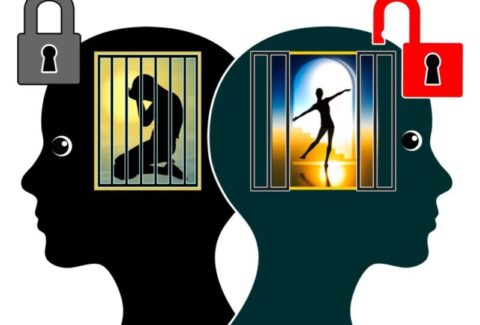The Dual Forces of Schemas
In the intricate dance between cognition and experience, schemas emerge as both the architects and architects of our mental landscapes. These cognitive constructs, born from the crucible of our encounters, wield the power to enhance cognitive efficiency, shape perceptions, and guide our responses to the world. Yet, the consequences of these mental shortcuts[1] are not a one-sided tale. Join us on a journey through the labyrinth of our minds as we explore the dual forces of schemas[2]—unveiling their prowess and unraveling the complexities they bring.
Cognitive Mastery: The Efficiency Enigma
In the realm of cognitive efficiency, schemas reign supreme. Like masterful conductors, they orchestrate the symphony of our thoughts, allowing us to swiftly process information and make decisions.[3] This cognitive efficiency is our mental lifeblood, empowering us to navigate the complexities of daily existence with remarkable ease.
But beware the shadows of cognitive biases[4]. As schemas streamline our thinking, they may inadvertently lead us down the path of bias, distorting perceptions and fostering errors in judgment. The very efficiency that enhances our cognitive prowess becomes a double-edged sword when faced with the unknown.
Perception’s Tapestry: The Art of Interpretation
Schemas, the artists of perception, paint our world with familiar strokes. They guide our interpretation of situations, creating a sense of coherence and stability. This perceptual mastery allows us to navigate familiar terrains with confidence and precision.
Yet, in the gallery of interpretation, echoes of misjudgment linger. Schemas may sculpt our perceptions in ways that perpetuate stereotypes, creating a lens through which we view the world. This selective lens, while providing clarity, risks distorting the broader canvas of reality.[5]
Rigidity or Stability: The Paradox of Change
Schemas offer a comforting stability in the face of life’s uncertainties. They provide a sense of continuity, a mental anchor in the ever-changing tides of experience. This stability becomes our haven, offering solace in a world of flux.
Yet, the fortress of stability may transform into a prison of resistance. Rigidity in schemas[6], born from a desire for stability, may hinder our ability to adapt to new information and circumstances. The very anchor meant to provide security becomes a chain that restrains our growth.
The Social Mosaic: Unity and Division
In the tapestry of social understanding[7], schemas are the threads that bind us. They create shared frameworks for interpreting cultural norms, facilitating harmonious social interactions. This unity in understanding becomes the glue that holds communities together.
However, the threads of understanding may fray in the face of diversity. Conflicting schemas among individuals may lead to misunderstandings, creating fault lines in the social fabric. What should unite us sometimes becomes the source of division.
Memory’s Symphony: Harmonizing the Past
Schemas compose the symphony of memory[8], harmonizing our past experiences. They facilitate memory encoding and retrieval, weaving a narrative that gives coherence to our life story. This harmonious interplay with memory becomes the foundation of our identity.
Yet, memory’s melody may be tinged with distortion. Schemas, while aiding memory, may contribute to the creation of false memories or selective recall. The stories we tell ourselves may bear the imprints of our schemas, leading to a nuanced dance between truth and perception.
Conclusion: A Symphony of Mind and Experience
In the grand symphony of cognition, schemas emerge as the conductors, composers, and performers, shaping the melodies that echo through our minds. The consequences of their influence are a complex interplay of light and shadow, efficiency and bias, stability and rigidity. To navigate this cognitive seascape, we must become mindful sailors, steering through the currents of our schemas with intention and awareness.
As we unravel the dual forces of schemas, let us embrace their power while acknowledging their potential pitfalls. In this journey of self-discovery, may we cultivate a harmony that transcends the confines of bias, adapts to the ever-changing melodies of experience, and celebrates the rich diversity that defines the human cognitive experience. The symphony of schemas is an ongoing masterpiece—a canvas where each note, each perception, and each adaptation contributes to the ever-evolving composition of our minds.
Schema Therapy[9] offers a solution where Cognitive Behavioral Therapy may have fallen short. It integrates various evidence-based practices, including attachment theory, psychodynamic psychotherapy, mindfulness, and Gestalt therapy. This holistic approach blends the best of each method to engage clients effectively. Join our upcoming 6-Week Schema Therapy Certificate Course starting on July 2, 2024 and concluding on August 13, 2024. Secure your spot now by clicking here. Don’t miss out on this transformative opportunity. Take action today!
[1] Nathaniel, Karene-Anne. “Mental Shortcuts.” The Routledge Handbook of Social Work Field Education in the Global South (2022): 313.
[2] Bach, Bo, George Lockwood, and Jeffrey E. Young. “A new look at the schema therapy model: organization and role of early maladaptive schemas.” Cognitive behaviour therapy 47.4 (2018): 328-349.
[3] Leung, Kwok, and Michael W. Morris. “Values, schemas, and norms in the culture–behavior nexus: A situated dynamics framework.” Journal of International Business Studies 46 (2015): 1028-1050.
[4] Beevers, Christopher G., et al. “Association between negative cognitive bias and depression: A symptom-level approach.” Journal of abnormal psychology 128.3 (2019): 212.
[5] Baldassano, Christopher, Uri Hasson, and Kenneth A. Norman. “Representation of real-world event schemas during narrative perception.” Journal of Neuroscience 38.45 (2018): 9689-9699.
[6] Feixas, Guillem, et al. “Measuring cognitive rigidity in construing self and others with the repertory grid technique: further test of the cognitive model for depression.” International Journal of Cognitive Therapy 14 (2021): 656-670.
[7] Boutyline, Andrei, and Laura K. Soter. “Cultural schemas: What they are, how to find them, and what to do once you’ve caught one.” American Sociological Review 86.4 (2021): 728-758.
[8] Gilboa, Asaf, and Hannah Marlatte. “Neurobiology of schemas and schema-mediated memory.” Trends in cognitive sciences 21.8 (2017): 618-631.
[9] Young, Jeffrey E., Janet S. Klosko, and Marjorie E. Weishaar. “Schema therapy.” New York: Guilford 254 (2003): 653-658.







